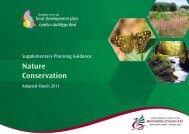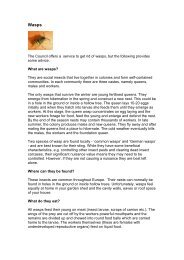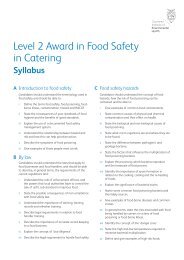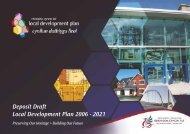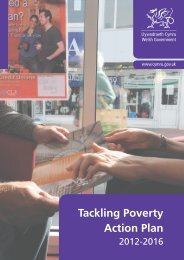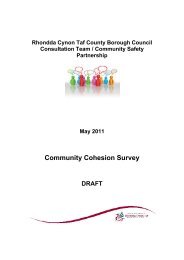Delivering design and Placemaking - Rhondda Cynon Taf
Delivering design and Placemaking - Rhondda Cynon Taf
Delivering design and Placemaking - Rhondda Cynon Taf
- No tags were found...
Create successful ePaper yourself
Turn your PDF publications into a flip-book with our unique Google optimized e-Paper software.
Supplementary Planning Guidance4.5.10 Whilst the concept of reduced carriageway widths meets many of theobjectives in the new thinking on residential layouts – they will onlywork if detailed consideration is given to parking. There are strongpossibilities that parking will occur wherever it is remotely possible, orvehicles will use part of the footway. The highway <strong>design</strong> must wherenecessary <strong>design</strong> out inappropriate parking opportunities, plus ensurethere is appropriate space for parking. Car ownership will remain highso residential layouts must accommodate the parked vehicle whileoffering alternatives to its use.4.5.11 Regard should also be had to the details contained within <strong>Rhondda</strong><strong>Cynon</strong> <strong>Taf</strong>’s “Residential, Industrial <strong>and</strong> Commercial Estate RoadsDesign Guide”. These include engineering st<strong>and</strong>ards for highway<strong>design</strong>. However, it is important that <strong>design</strong>ers primarily <strong>design</strong> places<strong>and</strong> consider the highway arrangements that are appropriate for theplace being created in each circumstance. They should not make newsites look heavily engineered. More advice is given in this respect in theDesign <strong>and</strong> <strong>Placemaking</strong> SPG.4.5.4 Public Rights of Way4.5.13 The effect of development on a public right of way, as defined by theCountryside Act 1981, is a material consideration in the determinationof planning applications.4.5.14 Where possible, existing paths that are convenient link routes, haveclear recreational value or provide access to the countryside should beretained on their current line. However, it is sometimes possible todivert a path onto an equally convenient <strong>and</strong> attractive route, or ontoa better or more convenient route.4.5.15 Where there are new housing or other developments it may benecessary to create a new path to conveniently link with places of work,services, leisure <strong>and</strong> countryside. Such paths should be dedicated asnew public rights of way <strong>and</strong> added to the Definitive Map.4.5.16 There is potential for conflict between the path users <strong>and</strong> those wholive near the paths concerned. There is often a fear, real or perceived,of nuisance to those who live or work near to paths. The followingprinciples should be incorporated in the <strong>design</strong> of new paths or whereexisting paths are incorporated in a development:• Consider public rights of way at the early <strong>design</strong> stage;• Ensure paths are direct, well lit, open <strong>and</strong> clear of hiding places;• Set paths in l<strong>and</strong>scape strip to avoid nuisance to neighbouringproperties;• If possible keep paths away from sides <strong>and</strong> rear of properties;• Avoid planting hedges that may obscure the line of a path or makeaccess physically difficult;• Keep the widths of new paths sufficiently wide to make them seeminviting <strong>and</strong> easy for everyone to use.4.5.17 Developers should bear in mind the needs of the less able <strong>and</strong>disabled. Steep gradients steps <strong>and</strong> stiles can cause difficulties for wheelchair users, the elderly <strong>and</strong> for these with pushchairs. Paths should beproperly drained <strong>and</strong> although it is appreciated that would not beenvironmentally acceptable for most rural paths to be surfaced, incertain circumstances paths should be surfaced (contact CountrysideSection, Disability Wales or Fieldfare Trust for further advice).16 • Local Development Plan 2006 - 2021





